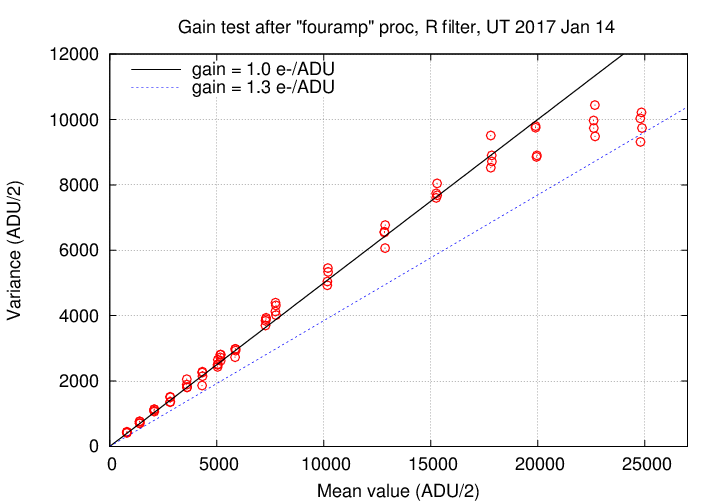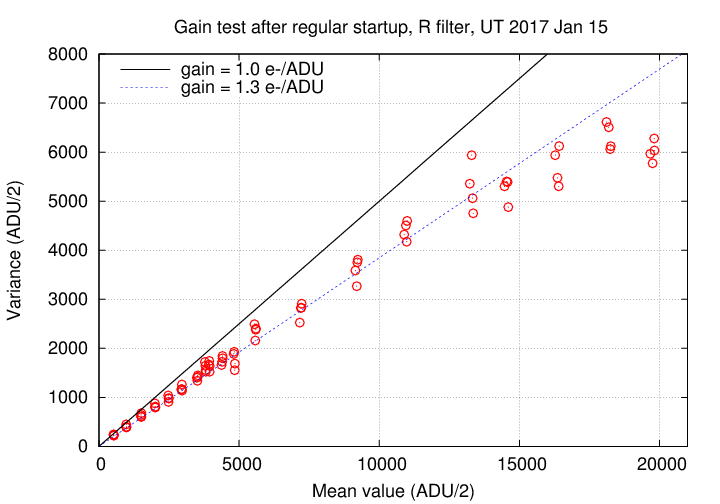
The HDI command shell includes several commands for setting the readout mode of the chip. By default, when one turns on the camera, it is in 4-amp mode. One can issue the following commands to choose 1-amp readout modes:
command comment in "help" screen ------------------------------------------------------------------------ oneamp ur Temporary mode for "Upper Right" amplifier only oneamp ul "Upper Left" amplifier mode (image display incorrect) oneamp lr "Lower Right" amplifier mode (image display incorrect) oneamp ll "Lower Left" amplifier mode (image display incorrect) ------------------------------------------------------------------------
Switching from 4-amp to 1-amp modes causes no problems; one can begin observing in 1-amp mode immediately. In particular, there is no persistent charge on the chip after making the change.
However, if one wishes to switch in the opposite direction -- from 1-amp to 4-amp readout mode -- then a problem can occur. If one makes the switch by cycling power to the camera, via
pof
pon
then there will be persistent charge created, which will take an hour or two to decay.
In early January, 2017, Sidik Isani created a new HDI command as a possible workaround for this annoyance. The command
fouramp
is designed to switch the chip from 1-amp to 4-amp readout mode without inducing the persistant charge. Sidik described it briefly in an E-mail:
#!/usr/bin/bash . config . functions for B in $BOARDSETS; do grasp_pon_e2vccd231 -A -a -c $B $PONFITS grasp_cmd $B detsize dev=all width=2156 height=2056 namp=2 adczero=6 # reference channels off. done
The user can invoke it from the HDI command shell by typing
fouramp
During an observing run in early January, 2017, I tried this new command. On UT 2017 Jan 14, I did the following:
c7766t0341 - 0345 300-sec dark exposures in 1-amp mode fouramp c7766t0346 - 0350 300-sec dark exposures in 4-amp mode
When I examined the images taken AFTER the fouramp command, I found no trace of persistent charge. The new command had done its job. GOOD!
However, I did discover something unexpected. Several hours later, after returning to 1-amp mode, my students and I took a series of dome flatfield exposures to check the gain of the chip. We measured the mean and variance in 4 small regions in each image, then plotted variance versus mean. The result should be a linear relationship, with a slope proportional to the inverse gain of the system; in other words, if we define "gain" to have units of "electrons per ADU",
1 1
slope = ------ * -----
gain 2
The factor of 1/2 is present due to a quirk of my data reduction procedure: I divide all raw pixel values by 2 before further analysis to avoid a certain type of integer overflow.
Below are the results of this set of exposures: remember, these are 1-amp images taken after running the fouramp procedure.

There is a nice, linear relationship at low light levels, just as we expect; it rolls over above 35,000 ADU or so, which is consistent with other tests of this device. But the slope of this line is NOT was I was expecting to see.
Previous tests had shown that the device has a gain of about 1.3 electrons per ADU. But this new test showed a value close to 1.0 electrons per ADU.
In addition, the value of raw pixels in the overscan region was also different than normal:
ordinary 1-amp overscan 1-amp overscan after "fouramp"
------------------------- --------------------------------
approx 2860 ADU approx 3680 ADU
The next day, after realizing that something had changed, I cycled power to HDI, then switched to 1-amp mode in the usual manner, via
oneamp ur
I then took another set of dome flatfield exposures at different light levels to measure the gain again. Here are the results:

The gain has returned to its usual value of 1.3 electrons per ADU. Phew. I checked the overscan region, and found that it, too, had returned to its usual value of around 2860 ADU.
The new fouramp procedure will switch the chip from 1-amp mode to 4-amp mode, as designed. However, it will also modify the usual gain value (from 1.3 to 1.0 electrons per ADU), and change the overscan value as well (increasing it by about 800 ADU).